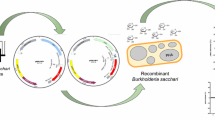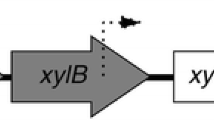Abstract
(2R,3R)-BDO is an important bio-based four-carbon platform compound and widely used in chemical, food, pharmaceutical, fuel and aerospace fields. Serratia marcescens has been shown to be an effective strain for producing BDO. However, there have been few reports on the metabolic engineering of this strain to efficiently produce (2R,3R)-BDO using xylose. In this study, the endogenous strong promoter was screened and modified, and combined with the screened RBS. (2R,3R)-BDO was successfully produced by combining the selected promoters and RBS with the overexpressed key enzymes (ALS, ALSD, BDH, GLF) of (2R,3R)-BDO production. The optimum fermentation temperature and pH were 37 ℃ and 6.0, respectively, and the optimized yield reached 6.0 g/L. After batch fermentation, the (2R,3R)-BDO yield reached 36.6 g/L. This provided a good idea for efficient production of (2R,3R)-BDO from xylose.







Similar content being viewed by others
Data availability
There are no additional supplementary materials.
References
Harden A. 2,3-Butylene glycol fermentation by Aerobacter aerogenes. Proc R Soc B. 1906;77:399–405.
Bartowsky EJ, Henschke PA. The “buttery” attribute of wine–diacetyl–desirability, spoilage and beyond. Int J Food Microbiol. 2004;96:235–52.
Xiu ZL, Zeng AP. Present state and perspective of downstream processing of biologically produced 1,3-propanediol and 2,3-butanediol. Appl Microbiol Biotechnol. 2008;78:917–26.
Celinska E, Grajek W. Biotechnological production of 2,3-butanediol–current state and prospects. Biotechnol Adv. 2009;27:715–25.
Yan Y, Lee CC, Liao JC. Enantioselective synthesis of pure (R, R)-2,3-butanediol in Escherichia coli with stereospecific secondary alcohol dehydrogenases. Org Biomol Chem. 2009;7:3914–7.
Li L, Wang Y, Zhang L, Ma C, Wang A, Tao F, Xu P. Biocatalytic production of (2S,3S)-2,3-butanediol from diacetyl using whole cells of engineered Escherichia coli. Bioresour Technol. 2012;115:111–6.
Celinska E, Grajek W. Biotechnological production of 2,3-butanediol-Current state and prospects. Biotechnol Adv. 2009;27:715–25.
Zeng AP, Biebl H, Deckwer WD. Production of 2,3-Butanediol in a Membrane Bioreactor with Cell Recycle. Appl Microbiol Biotechnol. 1991;34:463–8.
Wong CL, Huang CC, Lu WB, Chen WM, Chang JS. Producing 2,3-butanediol from agricultural waste using an indigenous Klebsiella sp Zmd30 strain. Biochem Eng J. 2012;69:32–40.
Li LX, Li K, Wang K, Chen C, Gao C, Ma CQ, Xu P. Efficient production of 2,3-butanediol from corn stover hydrolysate by using a thermophilic Bacillus licheniformis strain. Bioresour Technol. 2014;170:256–61.
Kou MY, Cui ZZ, Fu J, Dai W, Wang ZW, Chen T. Metabolic engineering of Corynebacterium glutamicum for efficient production of optically pure (2R,3R)-2,3-butanediol. Microb Cell Fact. 2022;21:150.
Syu MJ. Biological production of 2,3-butanediol. Appl Microbiol Biotechnol. 2001;55:10–8.
Zhang LY, Yang YL, Sun JA, Shen YL, Wei DZ, Zhu JW, Chu J. Microbial production of 2,3-butanediol by a mutagenized strain of Serratia marcescens H30. Bioresour Technol. 2010;101:1961–7.
Rao B, Zhang LY, Sun JA, Su G, Wei DZ, Chu J, Zhu JW, Shen YL. Characterization and regulation of the 2,3-butanediol pathway in Serratia marcescens. Appl Microbiol Biotechnol. 2012;93:2147–59.
Ha SJ, Kim SR, Kim H, Du J, Cate JHD, Jin YS. Continuous co-fermentation of cellobiose and xylose by engineered Saccharomyces cerevisiae. Bioresour Technol. 2013;149:525–31.
Shcherbo D, Murphy CS, Ermakova GV, Solovieva EA, Chepurnykh TV, Shcheglov AS, Verkhusha VV, Pletnev VZ, Hazelwood KL, Roche PM, Lukyanov S, Zaraisky AG, Davidson MW, Chudakov DM. Far-red fluorescent tags for protein imaging in living tissues. Biochemical Journal. 2009;418:567–74.
Kurgan G, Onyeabor M, Holland SC, Taylor E, Schneider A, Kurgan L, Billings T, Wang X. Directed evolution of Zymomonas mobilis sugar facilitator Glf to overcome glucose inhibition. J Indust Microbiol Biotechnol. 2022;49(2):kuab066.
Zhao FJ, Liu XS, Kong A, Zhao YX, Fan X, Ma T, Gao WX, Wang SF, Yang C. Screening of endogenous strong promoters for enhanced production of medium-chain-length polyhydroxyalkanoates in Pseudomonas mendocina NK-01. Sci Rep. 2019;9(1):1798.
Siegl T, Tokovenko B, Myronovskyi M, Luzhetskyy A. Design, construction and characterisation of a synthetic promoter library for fine-tuned gene expression in actinomycetes. Metab Eng. 2013;19:98–106.
Ji XJ, Huang H, Ouyang PK. Microbial 2,3-butanediol production: A state-of-the-art review. Biotechnol Adv. 2011;29:351–64.
Maina, S., Prabhu, A. A., Vivek, N., Vlysidis, A., Koutinas, A., and Kumar, V. (2022) Prospects on bio-based 2,3-butanediol and acetoin production: Recent progress and advances. Biotechnol Adv 54.
Bai F, Dai L, Fan J, Truong N, Rao B, Zhang L, Shen Y. Engineered Serratia marcescens for efficient (3R)-acetoin and (2R,3R)-2,3-butanediol production. J Ind Microbiol Biotechnol. 2015;42:779–86.
Blazeck J, Alper HS. Promoter engineering: recent advances in controlling transcription at the most fundamental level. Biotechnol J. 2013;8:46–58.
Liu X, Yang H, Zheng J, Ye Y, Pan L. Identification of strong promoters based on the transcriptome of Bacillus licheniformis. Biotechnol Lett. 2017;39:873–81.
Hammer K, Mijakovic I, Jensen PR. Synthetic promoter libraries–tuning of gene expression. Trends Biotechnol. 2006;24:53–5.
Phan TT, Nguyen HD, Schumann W. Development of a strong intracellular expression system for Bacillus subtilis by optimizing promoter elements. J Biotechnol. 2012;157:167–72.
Johnson AO, Gonzalez-Villanueva M, Tee KL, Wong TS. An Engineered Constitutive Promoter Set with Broad Activity Range for Cupriavidus necator H16. ACS Synth Biol. 2018;7:1918–28.
Maiti IB, Gowda S, Kiernan J, Ghosh SK, Shepherd RJ. Promoter/leader deletion analysis and plant expression vectors with the figwort mosaic virus (FMV) full length transcript (FLt) promoter containing single or double enhancer domains. Transgenic Res. 1997;6:143–56.
Yang TW, Rao ZM, Zhang X, Xu MJ, Xu ZH, Yang ST. Metabolic engineering strategies for acetoin and 2,3-butanediol production: advances and prospects. Crit Rev Biotechnol. 2017;37:990–1005.
Repizo GD, Mortera P, Magni C. Disruption of the alsSD operon of Enterococcus faecalis impairs growth on pyruvate at low pH. Microbiology. 2011;157:2708–19.
Nan H, Seo SO, Oh EJ, Seo JH, Cate JHD, Jin YS. 2,3-Butanediol production from cellobiose by engineered Saccharomyces cerevisiae. Appl Microbiol Biotechnol. 2014;98:5757–64.
Zhang B, Li XL, Fu J, Li N, Wang ZW, Tang YJ, Chen T. Production of Acetoin through Simultaneous Utilization of Glucose, Xylose, and Arabinose by Engineered Bacillus subtilis. Plos One. 2016;11(7):e0159298.
Jin C, Huang Z, Bao J. High-Titer Glutamic Acid Production from Lignocellulose Using an Engineered Corynebacterium glutamicum with Simultaneous Co-utilization of Xylose and Glucose, ACS Sustainable Chem. Eng. 2020;8:6315–22.
Limtong S, Sringiew C, Yongmanitchai W. Production of fuel ethanol at high temperature from sugar cane juice by a newly isolated Kluyveromyces marxianus. Bioresour Technol. 2007;98:3367–74.
Anderson PJ, McNeil K, Watson K. High-Efficiency Carbohydrate Fermentation to Ethanol at Temperatures above 40 degrees C by Kluyveromyces marxianus var. marxianus Isolated from Sugar Mills. Appl Environ Microbiol. 1986;51:1314–20.
Acknowledgements
Thank all the authors for their contributions to this article.
Funding
Not applicable.
Author information
Authors and Affiliations
Contributions
TS: investigation, visualization, writing—original draft. DL and LZ: methodology, investigation, data curation, formal analysis. YC: conceptualization, supervision, writing—review and editing.
Corresponding author
Ethics declarations
Conflict of interests
The authors claim that there is no conflict of interest.
Consent for publication
All authors agree to be published in this journal.
Ethics approval and consent to participate
Not applicable.
Rights and permissions
Springer Nature or its licensor (e.g. a society or other partner) holds exclusive rights to this article under a publishing agreement with the author(s) or other rightsholder(s); author self-archiving of the accepted manuscript version of this article is solely governed by the terms of such publishing agreement and applicable law.
About this article
Cite this article
Sun, T., Liu, D., Zhang, L. et al. Efficient production of (2R, 3R)-butanediol from xylose by an engineered Serratia marcescens. Syst Microbiol and Biomanuf 4, 820–830 (2024). https://doi.org/10.1007/s43393-023-00219-7
Received:
Revised:
Accepted:
Published:
Issue Date:
DOI: https://doi.org/10.1007/s43393-023-00219-7




